In the previous article, we laid the foundation for good speaker placement by addressing imaging and soundstage concerns along with accurate bass response and combating SBIR issues. The previous article is good for people running full-range speakers. But if you have a subwoofer, or multiple subwoofers, it opens up a few possibilities for optimizing the audio system for a breathtaking response once the placement and treatment strategies are implemented.
Basic Subwoofer Placement
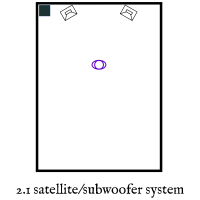 A typical setup for a system with two (stereo) satellites and a single subwoofer might look something like this, with the satellites placed as described in part one and a single subwoofer in teal, placed in the corner. Placing a sub in a corner will tend to excite many of the strongest room modes. If the sub is on the ground in the trihedral corner created by the floor, front wall, and side wall, then it will excite all 3 axial modes for the 3 dimensions of the room.
A typical setup for a system with two (stereo) satellites and a single subwoofer might look something like this, with the satellites placed as described in part one and a single subwoofer in teal, placed in the corner. Placing a sub in a corner will tend to excite many of the strongest room modes. If the sub is on the ground in the trihedral corner created by the floor, front wall, and side wall, then it will excite all 3 axial modes for the 3 dimensions of the room.
Exciting all these modes will almost certainly provide the most overall bass energy in the room from the subwoofer. At first listen, it can sound quite impressive and powerful. If the room has a good bass trapping strategy, then the room modes being excited in this way may not be as problematic and can sound much more controlled. But most often, corner placement for a single subwoofer does not produce anything close to a flat bass response since the modes are being excited due to the placement of the subwoofer.
¼ Placement
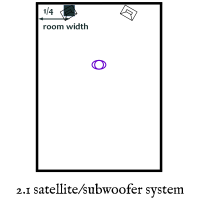 Another placement strategy is to have the low frequency driver in a null point, such as ¼ of the way across any room dimension or multiple dimensions. Placing the sub at this location means that the 2nd axial modes are not excited. In this image, the subwoofer is placed exactly at the null point for the 2nd axial mode related to width, and as a result, this mode is not excited. The same holds true for the other dimensions; one could theoretically place the subwoofer at the ¼ point for all three dimensions, though if we were to do that in this room, it would be floating between the listener and the left speaker! Regardless, this technique can be useful to produce a flatter overall response, particularly if the 2nd axial mode is problematic in your room.
Another placement strategy is to have the low frequency driver in a null point, such as ¼ of the way across any room dimension or multiple dimensions. Placing the sub at this location means that the 2nd axial modes are not excited. In this image, the subwoofer is placed exactly at the null point for the 2nd axial mode related to width, and as a result, this mode is not excited. The same holds true for the other dimensions; one could theoretically place the subwoofer at the ¼ point for all three dimensions, though if we were to do that in this room, it would be floating between the listener and the left speaker! Regardless, this technique can be useful to produce a flatter overall response, particularly if the 2nd axial mode is problematic in your room.
Crossover Tweaks
Other strategies can be used; one of the most effective is to tweak the crossover frequency for both the satellites and the subwoofers. This strategy requires a bit of room testing to identify where the peaks and nulls are located, so we can adjust the crossover frequencies of the system to work with sculpting the final room response. This strategy also obviously requires an adjustable crossover, where the frequencies for both the subwoofer and satellites are independently adjustable.
For instance, suppose a particular room has a strong peak resonance at around 70Hz. You could then cross the subwoofer over at 60Hz and the satellites at 80Hz, which can remove some energy from the peak and produce a flatter overall response (the exact frequency settings depend on the crossover slopes and the bandwidth of the peak in question). Careful adjustment of both crossover frequencies and levels can create a very accurate final response.
Using Multiple Subwoofers to Combat Axial Modes
We know bass waves interfere with one another, so why not manipulate this fact to our advantage? Using multiple subwoofers, and placing them in precise, specific ways can have the effect of canceling out modal resonances, thereby dramatically flattening the bass response. For instance, putting the subs in the front corners will excite the same room modes but from opposite points in the room, exactly 180 degrees out of phase with one another. Being out of phase in this way will cancel out the modal resonances, which can be hugely beneficial when creating a flat response within the subwoofers’ operating range.
As you can see, there are several configurations possible to get different effects on the room modes, depending on the needs of the room. Three of them are shown above. One is corner placement, where the two subs are placed in the front two corners. Next is 1/2 placement of both the front and the rear walls, which will further shift the modal response, putting the subwoofers in the null point of the first axial mode (rather than the second with ¼ placement). Or, you could move both subs ¼ of the way into the room from the corner, which can have the same benefit described above with both subwoofers, not exciting the 2nd axial mode for that dimension.
If you are using two subwoofers, it’s worth testing all these locations to see which gives you the best overall response, depending on which modes are most problematic in your room.
4 Subwoofers Can Be Even Better
For the truly dedicated, using four subwoofers can provide the best response, and furthers the capability of our subwoofer strategy to cancel out room modes. Again, there are several variations on this strategy:
All of these placements involve placing all four subwoofers in a place with specific effects on the room modes, so that their interactions can cancel out. Again, if you are running four subwoofers I’d experiment with all these placements to see which works best for you. Chances are, all else being equal, the ¼ placement strategy will yield the flattest results, theoretically canceling all odd-order axial modes and the first even order axial mode. This performance comes at a price, however, since it intrudes more on the aesthetic and flow of the room with four subwoofers toward the middle of the room. For dedicated rooms where these specific setups are a possibility, it’s worth exploring using four subwoofers for maximum results. As a practical matter, using two subwoofers in this way still performs quite well, far better than a single subwoofer, and should be achievable even in some non-dedicated rooms. At the other end of the spectrum, using even more than 4 subwoofers may theoretically be better still, but practically speaking there’s not much more improvement beyond four subwoofers.
Yes, You Still Need Bass Trapping
As valuable as these subwoofer placement strategies are, they do not by any stretch eliminate the need for bass trapping in a room. This point cannot be emphasized enough. All rooms have a multitude of bass problems apart from modal issues. But a well-implemented multiple subwoofer strategy combined with a bass trapping can produce outstanding results, giving you a solid foundation for accurate low end in a superior listening room.
Read more about Bass Trapping →
When In Doubt, Ask For Help
As always, we are happy to help you strategize about how to get the most out of your speakers with good placement strategies and patented GIK Acoustics treatments. Contact us for free acoustical advice.
James Lindenschmidt is GIK Acoustics’ resident audiogeek. He records music, designs studios & listening rooms, and consults with clients to make better audio. He also writes and makes mead, at least until the revolution comes.





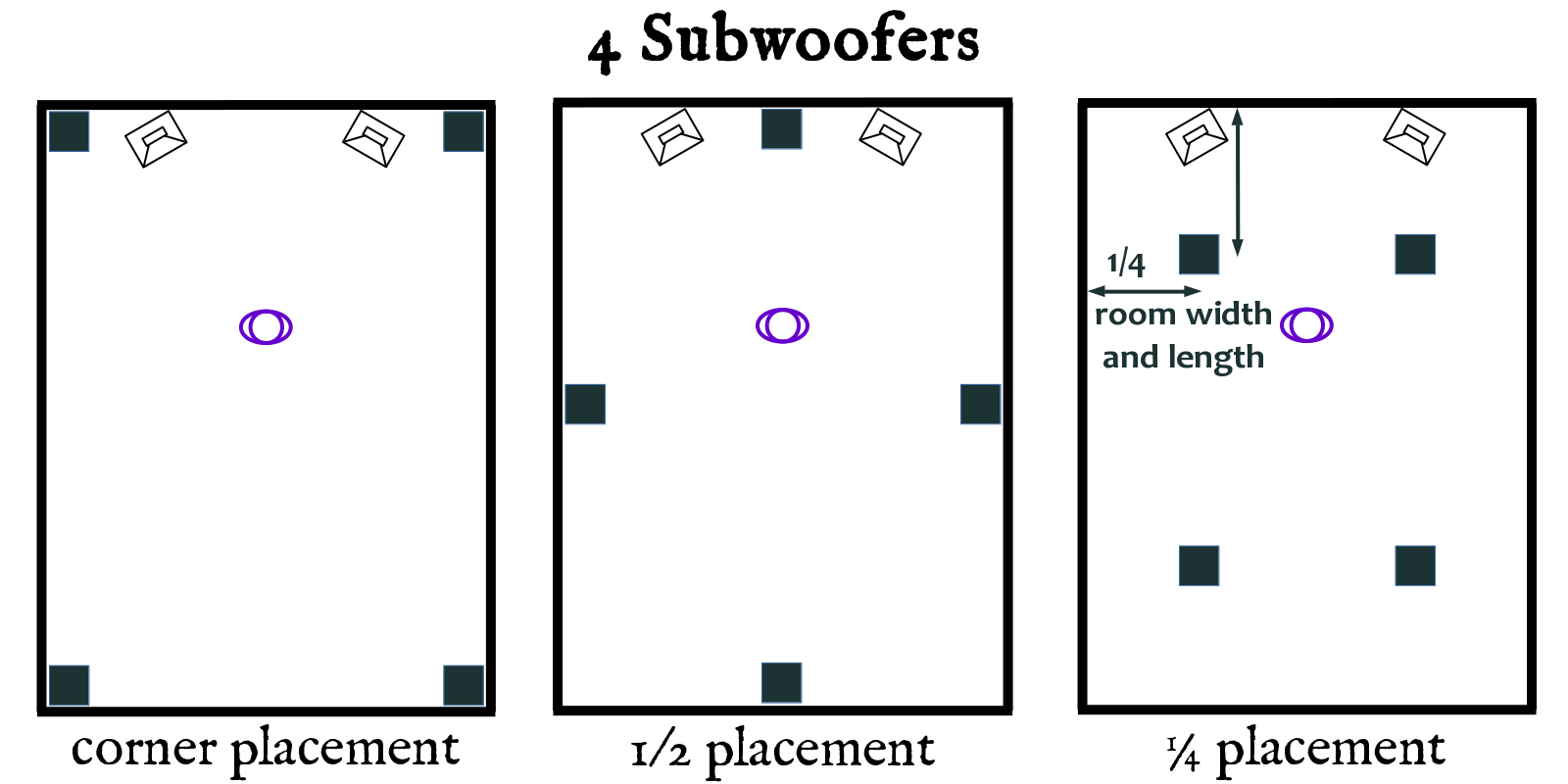



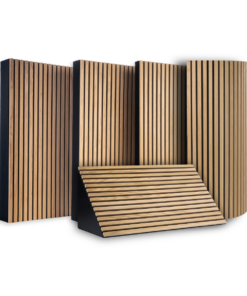

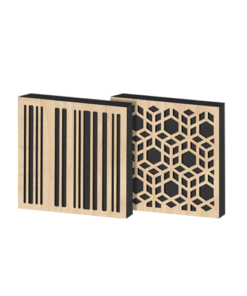
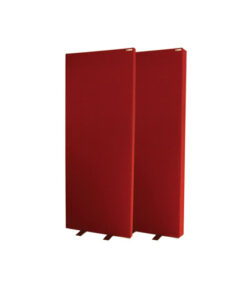





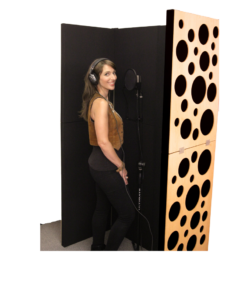



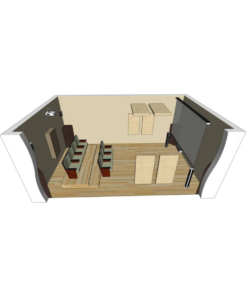
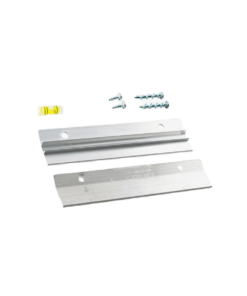
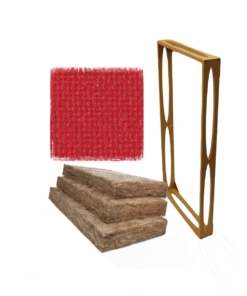



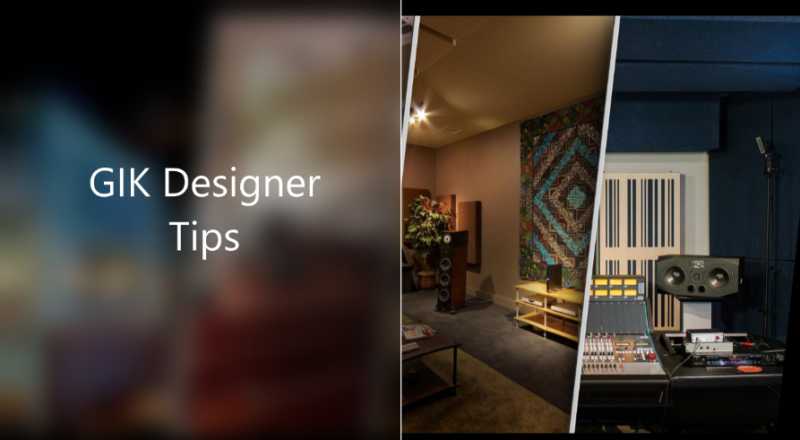


Great article James.
I have a rectangular room 30 feet long and sit 7.5 feet from the rear wall – very close to my floor standing Avalon speakers ( which are therefore miles away from the front wall).
I run 2 subwoofers each in the 1/2 placement position you describe above (a metre from those walls as there is a radiator on each one ).
I get a nice flat bass frequency response in my listening position and no boominess, but I think I might be sitting in a null point as I’m almost exactly one quarter of the rooms length from the rear wall (the rear is actually a bay window so that rear boundary is not exactly fully square).
Any advice / thoughts on this ?
Kind regards
Howard
Nice job on the test! Yes, it’s quite possible you are in a null spot…. best way to tell is to experiment by trying different listening positions to see. If your room is a simple rectangular room then I often recommend being 3/8 out from a wall, rather than 1/4…. good luck!
hi
i’m a sound guy in a community center where lots of different things happen and the system needs to be unobtrusive. we have hanging mains and a sub we roll out for music shows. but i was wondering about a sub or two mounted in the attic and pointing down through an opening in the ceiling. this would be super convenient for setup and i would have a lot of freedom to place them just so to avoid room modes. what do you think?
Hi Dan, it’s possible that could work. Is there any chance you could contact me via phone or email to discuss your situation?